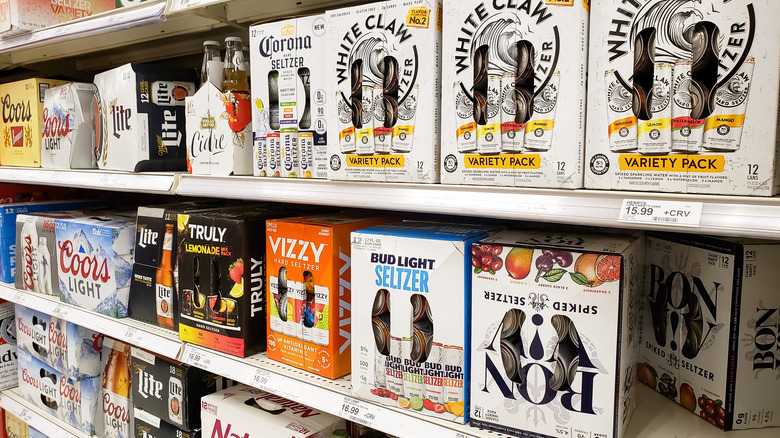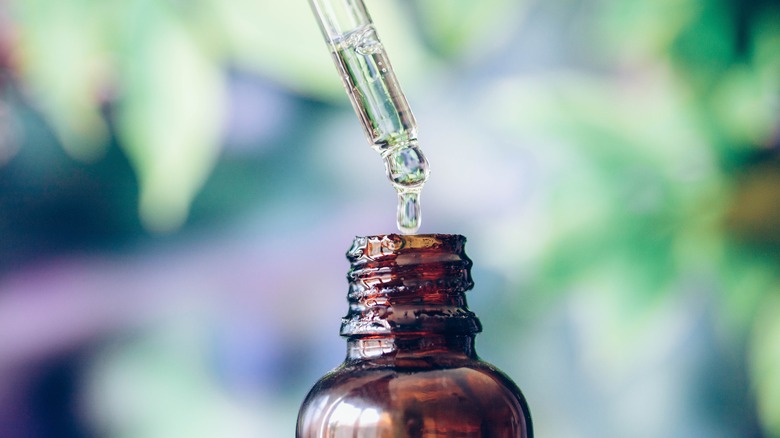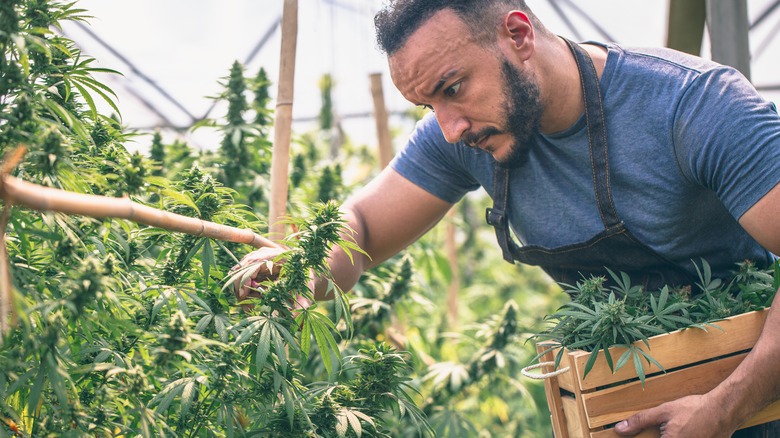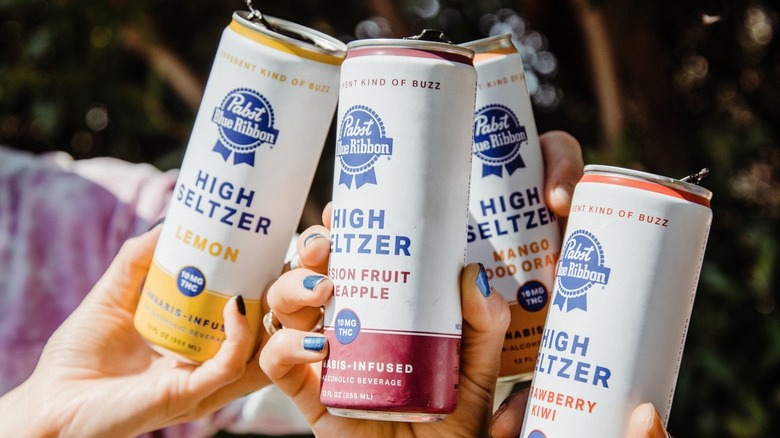How Cannabis Invaded The Fast-Growing Seltzer Industry
Ever since the White Claw boom of 2019, America has been hooked on hard seltzer. While the brand may sell the OG popular drinks in this category, hard seltzers have since evolved to include brands like Truly, High Noon, and Bud Light. But it's not just increasing numbers of alcohol brands and creative beverage flavors taking these beloved products to the next level. Companies now incorporate another major trend: cannabis.
What does that look like? The colorful canned boozy beverages you know and love, minus the alcohol but infused with THC. Aside from the ever-increasing popularity of cannabis, these drinks were partly created for a more adult audience – people who enjoy the flavor of their seltzer as well as the effects of THC, and who want a different way to consume cannabis than how they may have in college. Plus, the 2010s brought an influx of states legalizing recreational marijuana, including Colorado in 2012, Oregon in 2014, and Massachusetts in 2016. But do the drinks actually taste good? And what does it even feel like to have one? Let's find out.
What are cannabis-infused seltzers?
So, how do companies infuse cannabis into their seltzers? Through a process called emulsification. Since cannabis doesn't naturally dissolve in water, earlier versions of these drinks may have included floating bits of the stuff — not exactly appetizing. But with the newer method, companies use emulsifying agents to make cannabis oil molecules water-soluble by covering them in a hydrophilic coating. The agents also break down the oil drops into smaller substances that can evenly mix with water, so you're not getting all your THC at the bottom of the can.
And as you may expect from a THC-infused seltzer, they can get you high. But not all of these drinks are created equal. Some are just produced with microdoses of cannabis, so you'll only feel slight effects after one can. For example, Cann Cannabis-infused Social Tonics only contain two mg of THC, along with four mg of CBD. However, some brands deliver higher amounts — and since THC absorbs into your bloodstream quicker than edibles, you'll likely feel the effects right away. There are other purported benefits of these new types of seltzers too. They're marketed as a healthier high, leaving you with a calmer buzz and without a hangover the next morning. However, limited research has been conducted concerning the long-term effects of these drinks on the body.
What did early versions of cannabis seltzers look like?
As mentioned, the first, less-than-appealing versions of cannabis seltzers often featured little bits of the THC-filled substances floating throughout the cans. And even if people managed to stomach the taste and texture, it was difficult to tell if and when the seltzers got you high. The cannabis wasn't consistent throughout the drink, so you never knew if you would feel the effects halfway through, at the first sip, or only when you were almost finished with your can.
But emulsification changed the game. Technically, cannabis drinks have been around in the U.S. since 2010 — but according to Cannabis Tech, they really took off between 2020 and 2021, when the THC beverage market increased by 63%. As they became more popular, brands innovated the drinking experience as well. Earlier versions of THC-infused seltzers tended to contain higher doses of cannabis, so it made more sense to take shots of them than to slowly sip. In the years since, many have lowered their doses to invite a more casual (and potentially safer) drinking environment.
What do cannabis seltzers look like today?
Today, cannabis drinks look much different than they did in 2010. Take Pabst, for example — its High Seltzers come in a variety of fun flavors, including mango blood orange, strawberry kiwi, and passion fruit pineapple. Or Cann, which emphasizes the all-natural flavors, "locally-sourced cannabis extract (the purest we can find)," and the hangover-free benefits of drinking its seltzers. "Every ingredient is hand picked for quality and comes from the best place in the world to find that particular thing, like organic lemons from Sicily where the volcanic ash helps to bring out a really warm and bright acidity," Cann's co-founder, Luke Anderson, told Food & Wine. You probably can't say the same about your can of White Claw.
Despite the innovation, more research needs to be done to determine the exact benefits of switching from alcoholic seltzers to cannabis-based ones. The U.S. Food and Drug Administration (FDA) doesn't currently regulate most cannabis products, and cannabis isn't yet legalized for recreational use in all states. And though some of these drinks promise they won't give you a hangover, it's still possible to overdo it — especially when each brand offers varying amounts of THC. Pabst advises consuming responsibly, but just like with alcohol, what that means will be unique to each individual.



